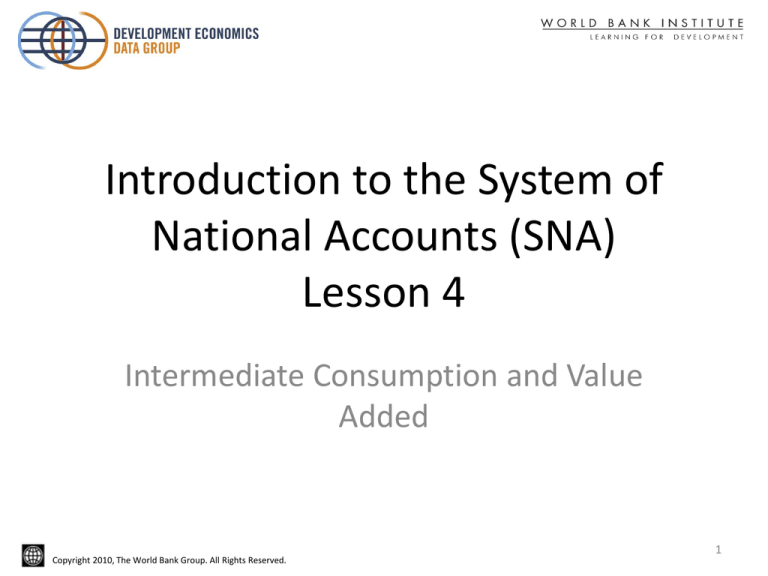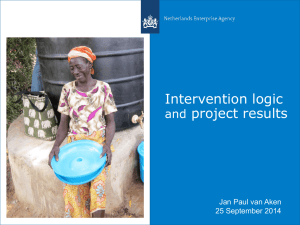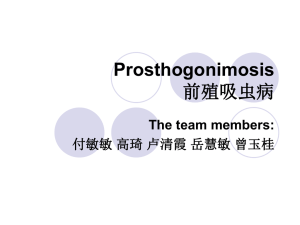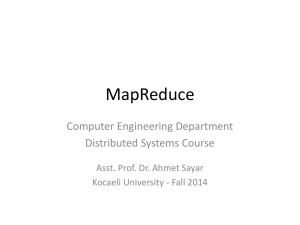
Introduction to the System of
National Accounts (SNA)
Lesson 4
Intermediate Consumption and Value
Added
Copyright 2010, The World Bank Group. All Rights Reserved.
1
Intermediate Consumption
• “Intermediate consumption consists of the
value of the goods and services consumed as
inputs by a process of production, excluding
fixed assets whose consumption is recorded as
consumption of fixed capital”. (SNA 2008, 6.213)
• “Consumed as inputs” means either
“disappears during the production process” or
“is physically transformed in some way”
Copyright 2010, The World Bank Group. All Rights Reserved.
2
Overheads
• By “overheads” we mean things like the costs of
keeping the accounts, seeking finance for the
business, finding new customers, market research
and advertising.
• In a bread factory, these are part of intermediate
consumption as much as wheat grain and water.
• Overhead expenses may be itemized in company
accounts but a subsidiary of a multinational
company may show them as a single line entry
such as “head office expenses”.
Copyright 2010, The World Bank Group. All Rights Reserved.
3
Intermediate consumption is not
equal to purchases of inputs
• We earlier noted that sales are not the same
as output because some production may go
into stocks of finished goods.
• In exactly the same way, purchases of goods
for use as inputs are not the same as
intermediate consumption.
• Intermediate consumption is equal to
purchases of inputs minus the increase in
stocks of inputs.
Copyright 2010, The World Bank Group. All Rights Reserved.
4
Borderline issues
•
•
•
•
•
Payments to government
Income in kind
Gross fixed capital formation
Valuables
Research and development and Military
equipment
Copyright 2010, The World Bank Group. All Rights Reserved.
5
Payments to government (1)
Some are intermediate consumption
• Most payments to government by producers are taxes
on production. But some charges made by
government are intermediate consumption.
• If the government provides a service commensurate
with the charge, then it is a payment for a service and
is part of intermediate consumption.
• Examples could be charges for certifying that accounts
are correct, charges for inspecting vehicles to make
sure they are road-worthy, passport fees ….
Copyright 2010, The World Bank Group. All Rights Reserved.
6
Payments to government (2)
Some are Taxes on Production
• “Taxes on production” are broken down into “Taxes on
products” and “Other taxes on production”.
• Taxes on products
– Depend on the values or quantities of products
– Only paid if there is some production
– Examples: VAT, sales taxes, customs duties, excise taxes
• Other taxes on production
– Are not related to the values or quantities of products
– Must be paid by a producer even if no production
– Examples: employment taxes, taxes on vehicles, taxes on
land and buildings
Copyright 2010, The World Bank Group. All Rights Reserved.
7
Does government
provide a service
commensurate with
the charge?
Yes
Intermediate
consumption
No
Does the charge
depend on the value or
quantity of goods or
services produced?
No
Copyright 2010, The World Bank Group. All Rights Reserved.
Yes
Taxes on
products
Other taxes
on production
8
Payments to government (3)
What goes into Intermediate consumption?
• Clearly if it is established that the payment to government is in
exchange for a genuine service, it must go into intermediate
consumption.
• If it is established that it is a “tax on products”, it is not relevant
because it is excluded from the Basic Price of output.
• But what do we do if it is decided that it is an ”other tax on
production”? From the producers point of view an “other tax on
production” is just a cost of production like any other.
• It may seem arbitrary, but in the national accounts we exclude it
from intermediate consumption.
Copyright 2010, The World Bank Group. All Rights Reserved.
9
Income in kind versus Intermediate consumption
Income in kind
• Transport to work
• Housing that can be used by
all members of the family
• Cheap or free tickets for
people working for airlines
or railway companies
• Free coal for coal miners
• Food and meals for factory
workers
Copyright 2010, The World Bank Group. All Rights Reserved.
Intermediate consumption
• Protective clothing and
uniforms
• Housing for construction
and mine workers
• Meals for soldiers on active
service
• Fares and hotel cost for
business travelers
• First aid and medical checkups
10
Intermediate consumption versus Capital
formation
• Maintenance and repairs of buildings and equipment are
intermediate consumption but major renovations are
Gross Fixed Capital Formation (GFCF).
• In the 1993 SNA, expenditures on computer software and
on mineral exploration are GFCF. (In the 1968 SNA they
were included in intermediate consumption.)
• In the 2008 SNA, expenditures on R&D and on weapons
are GFCF. (in the 1993 SNA they were included in
intermediate consumption.)
Copyright 2010, The World Bank Group. All Rights Reserved.
11
Valuables
• Valuables were an innovation of the 1993 SNA.
• Valuables are objects that are purchased in the
expectation that they will not lose their value and
may even become more valuable over time.
• If business buy “valuables” they are capital
formation not intermediate consumption.
Copyright 2010, The World Bank Group. All Rights Reserved.
12
Research and development and Military
equipment
Research and Development
Military Equipment
• R & D consists of
expenditures on creative
work undertaken on a
systematic basis in order to
increase the stock of
knowledge, and use of this
stock of knowledge to
devise new applications.
• Expenditures on military
equipment are treated as fixed
capital formation. Expenditure
on durable military goods such
as bombs and torpedoes are
recorded as inventories until
used when they are recorded
as intermediate consumption
and a withdrawal from
inventories. (SNA 2008, 6.232)
(SNA 2008, 10.103)
• In the 2008 SNA R&D is
GFCF and no longer
intermediate consumption.
Copyright 2010, The World Bank Group. All Rights Reserved.
• In the 1993 SNA weapons
were treated as intermediate
consumption
13
Value Added
• We have now defined gross output and decided
what is to be included in intermediate
consumption.
• The difference between these two is Value
Added.
• It is the value that has been added in changing
inputs into outputs through adding labour, capital
and (some would say) entrepreneurship.
• It is a key aggregate in economics and in
particular for studies of productivity and
economic growth.
Copyright 2010, The World Bank Group. All Rights Reserved.
14
Dissecting Value Added: What is in
there?
Copyright 2010, The World Bank Group. All Rights Reserved.
15
Components of Value Added
• Compensation of employees
• Other taxes on production (minus other
subsidies on production)
• Gross operating surplus
Copyright 2010, The World Bank Group. All Rights Reserved.
16
Gross operating surplus has two components
Consumption of fixed capital
• CFC is the decline in the value of
fixed capital assets through
obsolescence and use in
production.
• It is a cost of production and
ideally it should be treated like
any other item of intermediate
consumption.
Copyright 2010, The World Bank Group. All Rights Reserved.
Net operating surplus
•
After deducting CFC, we are left
with net operating surplus
•
Some will be used to pay income
taxes and what is left will go to
those who have a “proprietary
interest” in the business – banks,
shareholders and owners.
•
The operating surplus of an
unincorporatede enterprise is
called “Mixed Income”, not
operating surplus.
17
What have we learned?
• Intermediate consumption (IC) consists of all current
production expenses including overheads.
• IC includes payment to government for any services
provided but excludes «other taxes on production».
• Intermediate consumption (IC) is deducted from
output to get value added.
• Value added is a balancing item and includes
compensation of employees, other taxes on
production, consumption of fixed capital and net
operating surplus.
Copyright 2010, The World Bank Group. All Rights Reserved.
18







